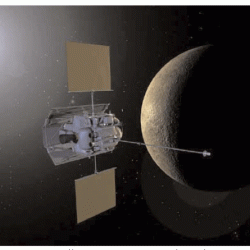Source Institutions
Source Institutions
Add to list Go to activity
Activity link broken? See if it's at the internet archive

In this activity, learners discover that one way to cool an object in the presence of a heat source is to increase the distance from it or change the angle at which it is faced. Learners perform an experiment that measures how the heat experienced by a test subject changes as the distance or the viewing angle changes. Learners distinguish which effect is more important for determining the seasons on Earth. Learners examine how NASA's MESSENGER mission to Mercury takes advantage of these passive cooling methods to keep the spacecraft comfortable in a high-temperature environment.
- 10 to 30 minutes
- 1 to 2 hours
- 1 cent - $1 per group of students
- Ages 8 - 14
- Activity, Experiment/Lab Activity, Lesson/Lesson Plan
- English
Quick Guide
Materials List (per group of students)
- Thermometers (with scale at least up to 50 ̊C, preferably up to 100 ̊C)
- Sheets of black construction paper
- Pieces of cardboard the same size as the construction paper
- Bricks or blocks to prop up cardboard
- Graphing paper
- Desk lamp or flood lamp (without lampshade)
- Meter sticks
- Masking tape
- Stopwatches
- Chair and books or blocks to prop up the lamp (if needed)
- Scissors or knives (to cut slit in paper)
- Colored pencils
- Blackboard or flipchart with markers
- Distance and Inclination student sheets
- Staying Cool with MESSENGER student sheets
Subjects
-
Earth and Space Science
-
Astronomy
- Probes, Satellites and Spacecraft
-
Earth Processes
- Weather and Climate
-
Earth, Moon and Sun
- Days
- Seasons
-
Solar System
- The Sun
-
Astronomy
-
Engineering and Technology
-
Engineering
- Aerospace Engineering
-
Engineering
-
Mathematics
-
Data Analysis and Probability
- Data Analysis
- Data Collection
- Data Representation
-
Geometry
- Plane Geometry
-
Measurement
- Circles
- Rate
- Reasoning and Proof
- Representation
-
Data Analysis and Probability
-
The Nature of Technology
-
The Design Process
- Problem Solving
-
The Design Process
-
Physical Sciences
-
Heat and Thermodynamics
- Heat and Temperature
- Heat Transfer
- Energy
-
Heat and Thermodynamics
-
The Nature of Science
-
The Scientific Process
- Asking Questions
- Conducting Investigations
- Gathering Data
- Formulating Explanations
- Communicating Results
-
The Scientific Process
Informal Categories
- Nature and Environment
- Outdoor Activity
Audience
To use this activity, learners need to:
- see
- see color
- read
- touch
Learning styles supported:
- Involves teamwork and communication skills
- Involves hands-on or lab activities
Other
Components that are part of this resource:
Includes alignment to state and/or national standards:
Includes assesments for student learning:
This resource is part of:
Access Rights:
- Free access
By:
Rights:
- All rights reserved, JHU/APL, 2010
Funding Source:
- Verizon Foundation Thinkfinity Program
